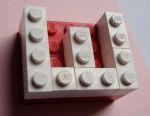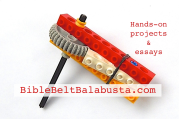DIY Lego Mezuzah with Kids
(Update: a revised version is now under my Make a Mezuzah: LEGO Mezuzah page.)
I’m a big fan of making mezuzah cases with kids, and especially out of found materials. In my house, Lego qualify as found material, as they are found under every large piece of furniture.
Making a ritual object out of repurposed materials with your kid is fun and Jewish (two words we like to link as often as possible), useful and meaningful. In the case of a mezuzah (pun intended), we can touch the container every time we enter a room, which gives us a physical connection to the Sh’ma prayer inside and the parent-child crafted case outside. Of course, we make sure the case is mounted low enough for kids to reach, too. (And the observant among us would have a kosher mezuzah higher up on the doorframe already. For mezuzah rules, see here.)
Other materials great for making mezuzah cases are: dental floss containers, toothbrush tubes, fat straws (from bubble tea), half a walnut shell, toothpaste boxes, plastic tubing and pretty much anything longer than it is wide and that will still fit on a doorpost. Laurie Bellet, author of The Reluctant Artist, posted a great idea at the Torah Aura blog about making cases from dried-out markers.
Do see my Kveller.com article about making training scrolls (as in “not kosher” scrolls) with kids and about making mezuzah cases from used glue stick containers and empty matchboxes.
But why Lego? Why not? Lego are fantastically fun building materials. And if you love Lego, you and your kid can happily fiddle with a pile of assorted bricks and come up with all sorts of designs.
The basic requirements are that the case is: big enough to hold a scroll, has a way to open and close to insert the scroll, and has a flat back for mounting to doorpost with tape.
The rest is left up to the imagination. My dream is to create a big letter Shin(the traditional decoration for any case) on the front using the tiny, single-knob round pieces, but I have so far been unable to meet this challenge.
To make a three-legged Shin requires five horizontal rows of knobs, and my flat plate is only four rows wide. I made a sample Shin (at left) which could easily attach it to the front of my mezuzah, but the thick profile (I don’t have the right kind of flat plates) would protrude too far into the doorway. Continue reading



























